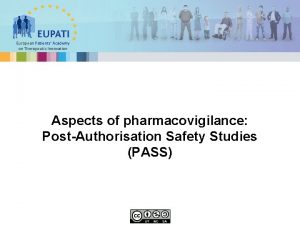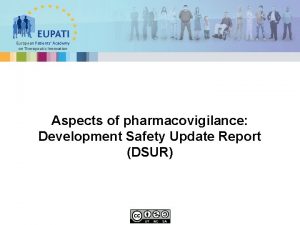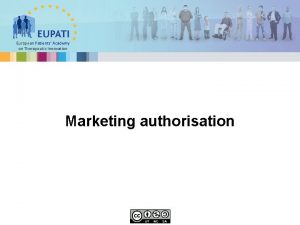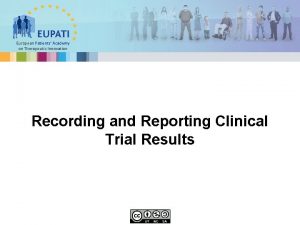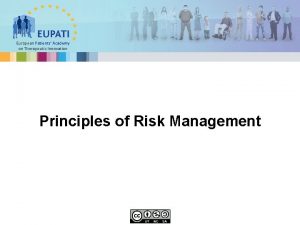European Patients Academy on Therapeutic Innovation Aspects of






- Slides: 6

European Patients’ Academy on Therapeutic Innovation Aspects of pharmacovigilance: Post-Authorisation Efficacy Studies (PAES)

Plans for Post-Authorisation Efficacy Studies (PAES) European Patients’ Academy on Therapeutic Innovation § “The aim is to enable regulators to request such studies when there are important questions about the efficacy of the medicine that can only be answered once the product is in general use, or when questions arise in the postauthorisation period” – Dr Stella Blackburn, EMA, 2011 2

Scope of PAESs European Patients’ Academy on Therapeutic Innovation At the time of granting the marketing authorisation • Where concerns relating to some aspects of the efficacy are identified and can be resolved only after the medicine has been marketed After granting the marketing authorisation • When the understanding of the disease or the clinical methodology indicate that previous efficacy evaluations might need to be significantly revised PAES should not lead to the premature granting of marketing authorisations. They cannot be used to compromise the initial level of evidence that is required to grant a standard marketing authorisation. 3

Who can trigger a PAES? European Patients’ Academy on Therapeutic Innovation § National Competent Authorities § The European Medicines Agency § The European Commission § PAESs are governed by EU Regulation No 357/2014 as regards situations in which post-authorisation efficacy studies may be required. § Available from http: //eur-lex. europa. eu/legalcontent/EN/TXT/PDF/? uri=OJ: JOL_2014_107_R_0001&from=E N (Last retrieved 29 September, 2015). 4

What points should a PAES address? (1) European Patients’ Academy on Therapeutic Innovation § An initial efficacy assessment based on surrogate endpoints that requires verification § In the case of medicinal products used in combination with other medicinal products, there may be a need for further efficacy data to clarify uncertainties § Uncertainties with respect to the efficacy of a medicinal product in certain sub-populations that could not be resolved prior to marketing authorisation § A change in the understanding of the standard of care for a disease or the pharmacology of a medicinal product 5

What points should a PAES address? (2) European Patients’ Academy on Therapeutic Innovation § The potential lack of efficacy in the long term that raises concerns with respect to the maintenance of a positive benefit-risk balance of the medicinal product. § Use of a medicinal product under real-life conditions may significantly affect the benefits the medicinal product demonstrated in clinical trials. In some cases, such as vaccines, protective efficacy studies have not been feasible during clinical trials. § New concrete and objective scientific factors that may constitute a basis for finding that previous efficacy evaluations may need to be significantly revised 6







